C402 Exam: Analyzing Operational Art in Operation Desert Shield
VerifiedAdded on 2023/06/15
|15
|4723
|249
Homework Assignment
AI Summary
This document presents a detailed solution to the C402 Operational Art & Design Exam, focusing on the strategic theater level of war with specific reference to Operation Desert Shield. The exam solution covers key aspects such as describing the operational environment in the summer of 1990 leadin...

Name: __________________________________ Date: __________________
C402 Operational Art & Design Exam AY 16-17
Instructions: The C402 Operational Art & Design Exam is worth 35% of the C400 block grade.
The exam is worth a total of 200 points and consists of a Part One and Part Two. C402 Part One
has six requirements; Part one focuses on the strategic theater level of war. C402 Part Two also
has six requirements for you to answer; Part Two focuses on the operational level of war.
You may use the C400 online lessons and readings to help you answer the exam; moreover, you
should not start the exam until you have finished both C401 and C402 lessons. View the
computer-based instruction (CBI), complete the lesson readings, and watch the instructional
videos prior to starting the C402 Exam.
All work must be your own. Do not discuss this examination or your answers with anyone other
than a Department of Distance Education (DDE) instructor or your academic advisor. Your
answers to the exam questions must be typed and double-spaced throughout, and must use Times
New Roman 12-pitch font and one-inch margins. Write your answers as complete sentences, not
as bulletized comments. This assignment does not have an associated CGSC Form 1009W
Writing Evaluation.
There is1 reading for the exam. Usethe“Operations DESERT SHIELD / DESERT STORM”
readings found in Blackboard. Read this document thoroughly, and then answer the exam
questions, which begin on page three of this document. The primary doctrinal reference is Joint
Publication 5-0 The Operations Process (2011). Other references include:
JP 1-0 Doctrine for the Armed Forces of the United States (2013)
JP 1-02 DOD Dictionary of Military and Associated Terms (2016)
JP 3-0 Joint Operations (2017)
If you state information from the lessons, readings, or doctrinal references as part of your
answer, you must give a citation in accordance with ST 22-2(Turabian endnotes or footnotes).
Overview:On 2 August 1990, Iraqi forces under Saddam Hussein invaded Kuwait with the intent
of placing what it claimed as its ‘nineteenth province’ under Iraqi control. President
Bushcondemned the invasion and met with the Chairman of the Joint Chiefs, General Colin
Powell;US Central Command Commander, General Norman Schwarzkopf; and National
Security Council members in determining a response to the Iraqi invasion of Kuwait.A decision
was made for US Central Command (USCENTCOM) to develop potential military options while
other senior United States Government officials conferred with neighboring nations in the
region. On August 4, USCENTCOM Commander, General Schwarzkopf, briefed President
Bush on a proposed plan for the deployment of a defensive force to Saudi Arabia.The following
day, senior United States Government (USG) officials consulted with King Fahd of Saudi Arabia
on the proposed defensive plan and to assure Saudi leaders of President Bush’s pledge of support
for the Kingdom’s security and stability. On 9 August 1990, an element of the XVIII Airborne
Corps arrived in Saudi Arabia in preparation for the arrival of the ready brigade of the 82d
Airborne Division in support of Operation Desert Shield. Operation Desert Shield would serve
1
C402 Operational Art & Design Exam AY 16-17
Instructions: The C402 Operational Art & Design Exam is worth 35% of the C400 block grade.
The exam is worth a total of 200 points and consists of a Part One and Part Two. C402 Part One
has six requirements; Part one focuses on the strategic theater level of war. C402 Part Two also
has six requirements for you to answer; Part Two focuses on the operational level of war.
You may use the C400 online lessons and readings to help you answer the exam; moreover, you
should not start the exam until you have finished both C401 and C402 lessons. View the
computer-based instruction (CBI), complete the lesson readings, and watch the instructional
videos prior to starting the C402 Exam.
All work must be your own. Do not discuss this examination or your answers with anyone other
than a Department of Distance Education (DDE) instructor or your academic advisor. Your
answers to the exam questions must be typed and double-spaced throughout, and must use Times
New Roman 12-pitch font and one-inch margins. Write your answers as complete sentences, not
as bulletized comments. This assignment does not have an associated CGSC Form 1009W
Writing Evaluation.
There is1 reading for the exam. Usethe“Operations DESERT SHIELD / DESERT STORM”
readings found in Blackboard. Read this document thoroughly, and then answer the exam
questions, which begin on page three of this document. The primary doctrinal reference is Joint
Publication 5-0 The Operations Process (2011). Other references include:
JP 1-0 Doctrine for the Armed Forces of the United States (2013)
JP 1-02 DOD Dictionary of Military and Associated Terms (2016)
JP 3-0 Joint Operations (2017)
If you state information from the lessons, readings, or doctrinal references as part of your
answer, you must give a citation in accordance with ST 22-2(Turabian endnotes or footnotes).
Overview:On 2 August 1990, Iraqi forces under Saddam Hussein invaded Kuwait with the intent
of placing what it claimed as its ‘nineteenth province’ under Iraqi control. President
Bushcondemned the invasion and met with the Chairman of the Joint Chiefs, General Colin
Powell;US Central Command Commander, General Norman Schwarzkopf; and National
Security Council members in determining a response to the Iraqi invasion of Kuwait.A decision
was made for US Central Command (USCENTCOM) to develop potential military options while
other senior United States Government officials conferred with neighboring nations in the
region. On August 4, USCENTCOM Commander, General Schwarzkopf, briefed President
Bush on a proposed plan for the deployment of a defensive force to Saudi Arabia.The following
day, senior United States Government (USG) officials consulted with King Fahd of Saudi Arabia
on the proposed defensive plan and to assure Saudi leaders of President Bush’s pledge of support
for the Kingdom’s security and stability. On 9 August 1990, an element of the XVIII Airborne
Corps arrived in Saudi Arabia in preparation for the arrival of the ready brigade of the 82d
Airborne Division in support of Operation Desert Shield. Operation Desert Shield would serve
1
Paraphrase This Document
Need a fresh take? Get an instant paraphrase of this document with our AI Paraphraser
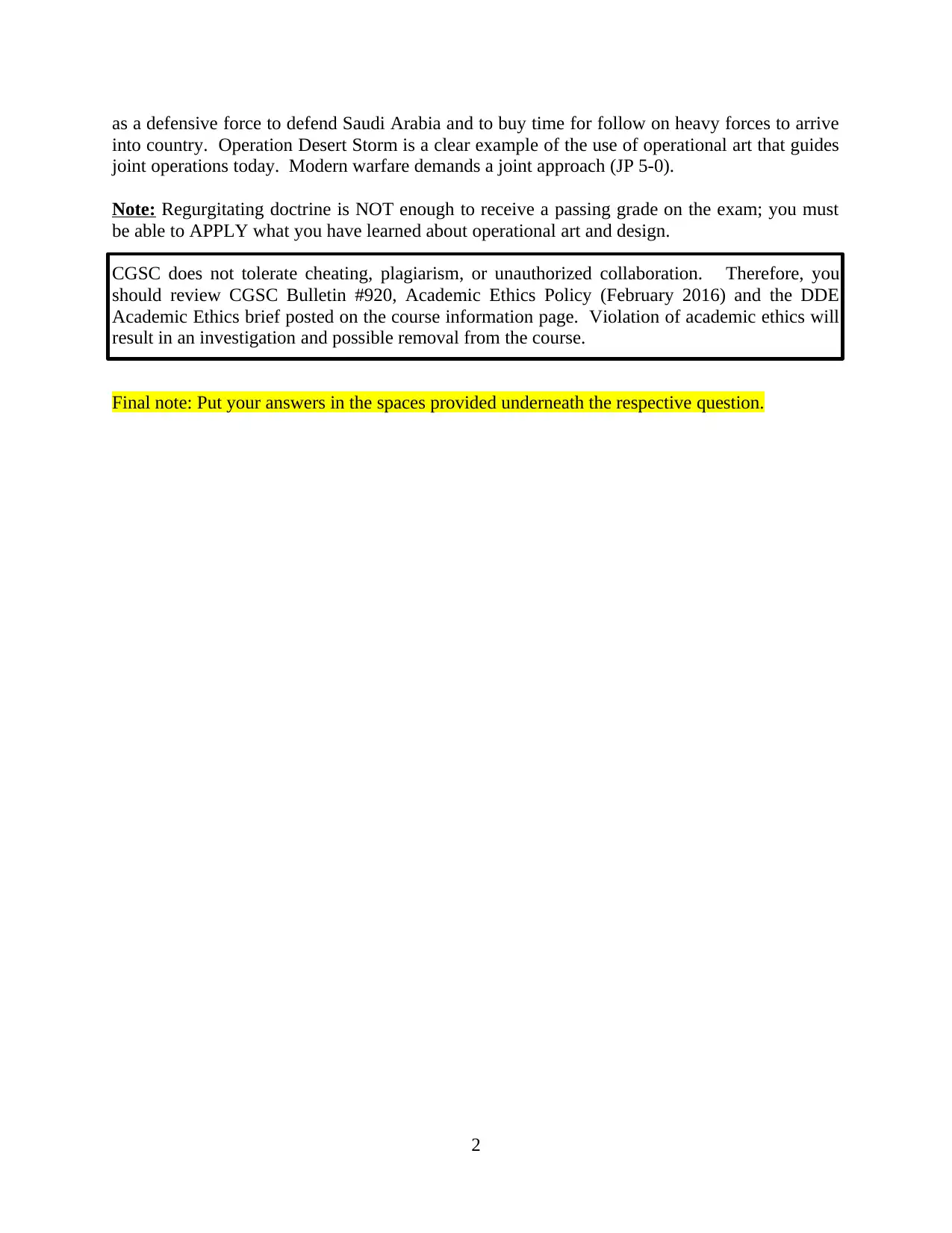
as a defensive force to defend Saudi Arabia and to buy time for follow on heavy forces to arrive
into country. Operation Desert Storm is a clear example of the use of operational art that guides
joint operations today. Modern warfare demands a joint approach (JP 5-0).
Note: Regurgitating doctrine is NOT enough to receive a passing grade on the exam; you must
be able to APPLY what you have learned about operational art and design.
CGSC does not tolerate cheating, plagiarism, or unauthorized collaboration. Therefore, you
should review CGSC Bulletin #920, Academic Ethics Policy (February 2016) and the DDE
Academic Ethics brief posted on the course information page. Violation of academic ethics will
result in an investigation and possible removal from the course.
Final note: Put your answers in the spaces provided underneath the respective question.
2
into country. Operation Desert Storm is a clear example of the use of operational art that guides
joint operations today. Modern warfare demands a joint approach (JP 5-0).
Note: Regurgitating doctrine is NOT enough to receive a passing grade on the exam; you must
be able to APPLY what you have learned about operational art and design.
CGSC does not tolerate cheating, plagiarism, or unauthorized collaboration. Therefore, you
should review CGSC Bulletin #920, Academic Ethics Policy (February 2016) and the DDE
Academic Ethics brief posted on the course information page. Violation of academic ethics will
result in an investigation and possible removal from the course.
Final note: Put your answers in the spaces provided underneath the respective question.
2
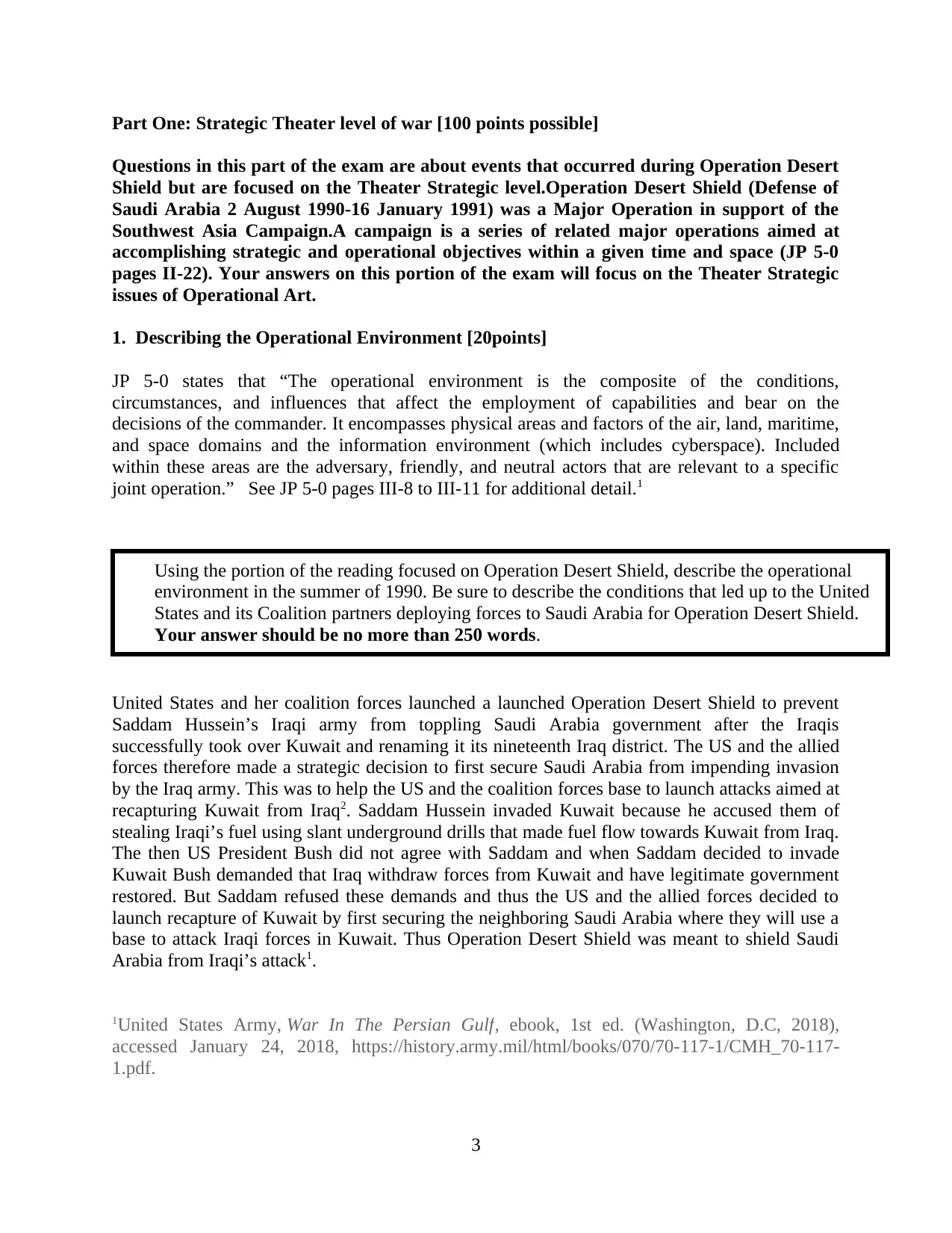
Part One: Strategic Theater level of war [100 points possible]
Questions in this part of the exam are about events that occurred during Operation Desert
Shield but are focused on the Theater Strategic level.Operation Desert Shield (Defense of
Saudi Arabia 2 August 1990-16 January 1991) was a Major Operation in support of the
Southwest Asia Campaign.A campaign is a series of related major operations aimed at
accomplishing strategic and operational objectives within a given time and space (JP 5-0
pages II-22). Your answers on this portion of the exam will focus on the Theater Strategic
issues of Operational Art.
1. Describing the Operational Environment [20points]
JP 5-0 states that “The operational environment is the composite of the conditions,
circumstances, and influences that affect the employment of capabilities and bear on the
decisions of the commander. It encompasses physical areas and factors of the air, land, maritime,
and space domains and the information environment (which includes cyberspace). Included
within these areas are the adversary, friendly, and neutral actors that are relevant to a specific
joint operation.” See JP 5-0 pages III-8 to III-11 for additional detail.1
United States and her coalition forces launched a launched Operation Desert Shield to prevent
Saddam Hussein’s Iraqi army from toppling Saudi Arabia government after the Iraqis
successfully took over Kuwait and renaming it its nineteenth Iraq district. The US and the allied
forces therefore made a strategic decision to first secure Saudi Arabia from impending invasion
by the Iraq army. This was to help the US and the coalition forces base to launch attacks aimed at
recapturing Kuwait from Iraq2. Saddam Hussein invaded Kuwait because he accused them of
stealing Iraqi’s fuel using slant underground drills that made fuel flow towards Kuwait from Iraq.
The then US President Bush did not agree with Saddam and when Saddam decided to invade
Kuwait Bush demanded that Iraq withdraw forces from Kuwait and have legitimate government
restored. But Saddam refused these demands and thus the US and the allied forces decided to
launch recapture of Kuwait by first securing the neighboring Saudi Arabia where they will use a
base to attack Iraqi forces in Kuwait. Thus Operation Desert Shield was meant to shield Saudi
Arabia from Iraqi’s attack1.
1United States Army, War In The Persian Gulf, ebook, 1st ed. (Washington, D.C, 2018),
accessed January 24, 2018, https://history.army.mil/html/books/070/70-117-1/CMH_70-117-
1.pdf.
3
Using the portion of the reading focused on Operation Desert Shield, describe the operational
environment in the summer of 1990. Be sure to describe the conditions that led up to the United
States and its Coalition partners deploying forces to Saudi Arabia for Operation Desert Shield.
Your answer should be no more than 250 words.
Questions in this part of the exam are about events that occurred during Operation Desert
Shield but are focused on the Theater Strategic level.Operation Desert Shield (Defense of
Saudi Arabia 2 August 1990-16 January 1991) was a Major Operation in support of the
Southwest Asia Campaign.A campaign is a series of related major operations aimed at
accomplishing strategic and operational objectives within a given time and space (JP 5-0
pages II-22). Your answers on this portion of the exam will focus on the Theater Strategic
issues of Operational Art.
1. Describing the Operational Environment [20points]
JP 5-0 states that “The operational environment is the composite of the conditions,
circumstances, and influences that affect the employment of capabilities and bear on the
decisions of the commander. It encompasses physical areas and factors of the air, land, maritime,
and space domains and the information environment (which includes cyberspace). Included
within these areas are the adversary, friendly, and neutral actors that are relevant to a specific
joint operation.” See JP 5-0 pages III-8 to III-11 for additional detail.1
United States and her coalition forces launched a launched Operation Desert Shield to prevent
Saddam Hussein’s Iraqi army from toppling Saudi Arabia government after the Iraqis
successfully took over Kuwait and renaming it its nineteenth Iraq district. The US and the allied
forces therefore made a strategic decision to first secure Saudi Arabia from impending invasion
by the Iraq army. This was to help the US and the coalition forces base to launch attacks aimed at
recapturing Kuwait from Iraq2. Saddam Hussein invaded Kuwait because he accused them of
stealing Iraqi’s fuel using slant underground drills that made fuel flow towards Kuwait from Iraq.
The then US President Bush did not agree with Saddam and when Saddam decided to invade
Kuwait Bush demanded that Iraq withdraw forces from Kuwait and have legitimate government
restored. But Saddam refused these demands and thus the US and the allied forces decided to
launch recapture of Kuwait by first securing the neighboring Saudi Arabia where they will use a
base to attack Iraqi forces in Kuwait. Thus Operation Desert Shield was meant to shield Saudi
Arabia from Iraqi’s attack1.
1United States Army, War In The Persian Gulf, ebook, 1st ed. (Washington, D.C, 2018),
accessed January 24, 2018, https://history.army.mil/html/books/070/70-117-1/CMH_70-117-
1.pdf.
3
Using the portion of the reading focused on Operation Desert Shield, describe the operational
environment in the summer of 1990. Be sure to describe the conditions that led up to the United
States and its Coalition partners deploying forces to Saudi Arabia for Operation Desert Shield.
Your answer should be no more than 250 words.
You're viewing a preview
Unlock full access by subscribing today!

2 Joint Operation Planning, ebook, 1st ed. (New York, 2011), accessed January 24, 2018,
https://grugq.github.io/resources/jp5_0.pdf.
2. U.S. Theater Strategic Level objectives [10points]
- Immediate, complete, and unconditional withdrawal of all Iraqi forces from Kuwait;
- Restoration of Kuwait's legitimate government;
- Security and stability of Saudi Arabia and the Persian Gulf; and
- Safety and protection of the lives of American citizens abroad3
3. Identifying Operational Risk [20points total]
“Operational design supports operational art with a general methodology usingelements of
operational design for understanding the situation and the problem.” (JP 5-0, III-2)
JP 5-0 states that an “Operational risk defines aspects of the campaign or operation in which the
commander will accept risk in lower or partial achievement or temporary conditions. It also
describes areas in which it is not acceptable to accept such lower or intermediate conditions.”
The United Sates and her coalition partners accepted operational by deploying elements of the
82d Airborne Division to Saudi Arabia so that the forces could buy time by engaging adversary
forces before the US and the allied forces could arrange themselves and launch a serious
offensive forces to defeat the Iraqis. The early forces sent to Saudi Arabia risked being killed all
of them because they were mainly defensive and not offensive forces. So in exchange of this
risk the US and the allied forces got time to prepare and assemble forces which will now try to
overcome Saddam’s forces in Kuwait. Another advantage is that the earlier 82d Airborne
Division forces prevented Iraqi forces from invading Saudi Arabia and taking up strategic
positions in Saudi Arabia which will mean before US and the coalition forces could rescue
Kuwait they will have first needed to defeat Saddam in Saudi Arabia to open the leeway to fight
Saddam in Kuwait. Geographically, Saudi Arabia borders Kuwait the other side is the Persian
4
What were the U.S. Theater Strategic Level objectives outlined by the President (POTUS)
forOperation Desert Shield? Your answer should be approximately 150 words.
Describe how the United States and its Coalition partners accepted operational risk (window
of vulnerability in the reading) in immediately deploying elements of the 82d Airborne
Division to Saudi Arabia in the early days of Operation Desert Shield. Your answer should
be no more than 250 words.
https://grugq.github.io/resources/jp5_0.pdf.
2. U.S. Theater Strategic Level objectives [10points]
- Immediate, complete, and unconditional withdrawal of all Iraqi forces from Kuwait;
- Restoration of Kuwait's legitimate government;
- Security and stability of Saudi Arabia and the Persian Gulf; and
- Safety and protection of the lives of American citizens abroad3
3. Identifying Operational Risk [20points total]
“Operational design supports operational art with a general methodology usingelements of
operational design for understanding the situation and the problem.” (JP 5-0, III-2)
JP 5-0 states that an “Operational risk defines aspects of the campaign or operation in which the
commander will accept risk in lower or partial achievement or temporary conditions. It also
describes areas in which it is not acceptable to accept such lower or intermediate conditions.”
The United Sates and her coalition partners accepted operational by deploying elements of the
82d Airborne Division to Saudi Arabia so that the forces could buy time by engaging adversary
forces before the US and the allied forces could arrange themselves and launch a serious
offensive forces to defeat the Iraqis. The early forces sent to Saudi Arabia risked being killed all
of them because they were mainly defensive and not offensive forces. So in exchange of this
risk the US and the allied forces got time to prepare and assemble forces which will now try to
overcome Saddam’s forces in Kuwait. Another advantage is that the earlier 82d Airborne
Division forces prevented Iraqi forces from invading Saudi Arabia and taking up strategic
positions in Saudi Arabia which will mean before US and the coalition forces could rescue
Kuwait they will have first needed to defeat Saddam in Saudi Arabia to open the leeway to fight
Saddam in Kuwait. Geographically, Saudi Arabia borders Kuwait the other side is the Persian
4
What were the U.S. Theater Strategic Level objectives outlined by the President (POTUS)
forOperation Desert Shield? Your answer should be approximately 150 words.
Describe how the United States and its Coalition partners accepted operational risk (window
of vulnerability in the reading) in immediately deploying elements of the 82d Airborne
Division to Saudi Arabia in the early days of Operation Desert Shield. Your answer should
be no more than 250 words.
Paraphrase This Document
Need a fresh take? Get an instant paraphrase of this document with our AI Paraphraser
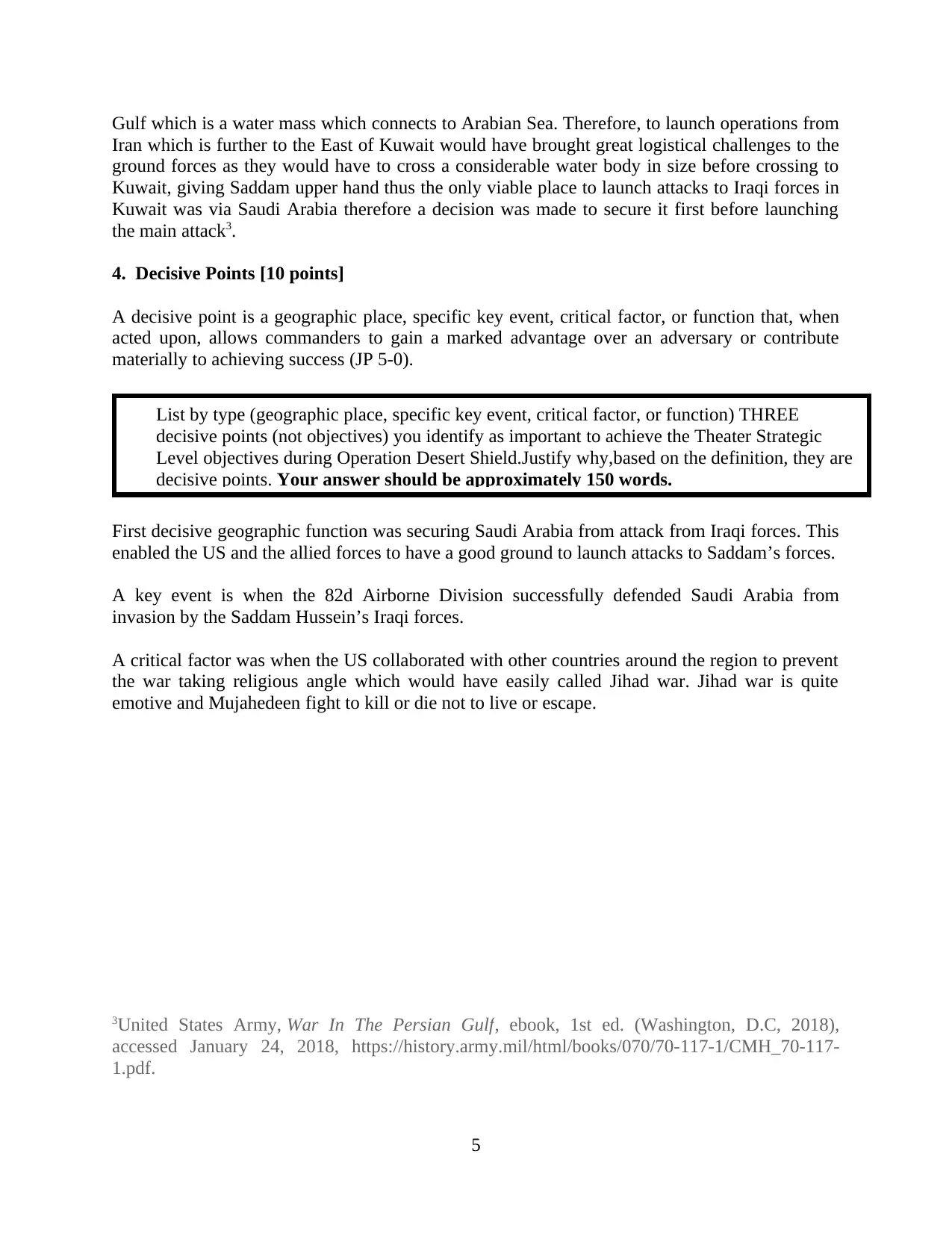
Gulf which is a water mass which connects to Arabian Sea. Therefore, to launch operations from
Iran which is further to the East of Kuwait would have brought great logistical challenges to the
ground forces as they would have to cross a considerable water body in size before crossing to
Kuwait, giving Saddam upper hand thus the only viable place to launch attacks to Iraqi forces in
Kuwait was via Saudi Arabia therefore a decision was made to secure it first before launching
the main attack3.
4. Decisive Points [10 points]
A decisive point is a geographic place, specific key event, critical factor, or function that, when
acted upon, allows commanders to gain a marked advantage over an adversary or contribute
materially to achieving success (JP 5-0).
First decisive geographic function was securing Saudi Arabia from attack from Iraqi forces. This
enabled the US and the allied forces to have a good ground to launch attacks to Saddam’s forces.
A key event is when the 82d Airborne Division successfully defended Saudi Arabia from
invasion by the Saddam Hussein’s Iraqi forces.
A critical factor was when the US collaborated with other countries around the region to prevent
the war taking religious angle which would have easily called Jihad war. Jihad war is quite
emotive and Mujahedeen fight to kill or die not to live or escape.
3United States Army, War In The Persian Gulf, ebook, 1st ed. (Washington, D.C, 2018),
accessed January 24, 2018, https://history.army.mil/html/books/070/70-117-1/CMH_70-117-
1.pdf.
5
List by type (geographic place, specific key event, critical factor, or function) THREE
decisive points (not objectives) you identify as important to achieve the Theater Strategic
Level objectives during Operation Desert Shield.Justify why,based on the definition, they are
decisive points. Your answer should be approximately 150 words.
Iran which is further to the East of Kuwait would have brought great logistical challenges to the
ground forces as they would have to cross a considerable water body in size before crossing to
Kuwait, giving Saddam upper hand thus the only viable place to launch attacks to Iraqi forces in
Kuwait was via Saudi Arabia therefore a decision was made to secure it first before launching
the main attack3.
4. Decisive Points [10 points]
A decisive point is a geographic place, specific key event, critical factor, or function that, when
acted upon, allows commanders to gain a marked advantage over an adversary or contribute
materially to achieving success (JP 5-0).
First decisive geographic function was securing Saudi Arabia from attack from Iraqi forces. This
enabled the US and the allied forces to have a good ground to launch attacks to Saddam’s forces.
A key event is when the 82d Airborne Division successfully defended Saudi Arabia from
invasion by the Saddam Hussein’s Iraqi forces.
A critical factor was when the US collaborated with other countries around the region to prevent
the war taking religious angle which would have easily called Jihad war. Jihad war is quite
emotive and Mujahedeen fight to kill or die not to live or escape.
3United States Army, War In The Persian Gulf, ebook, 1st ed. (Washington, D.C, 2018),
accessed January 24, 2018, https://history.army.mil/html/books/070/70-117-1/CMH_70-117-
1.pdf.
5
List by type (geographic place, specific key event, critical factor, or function) THREE
decisive points (not objectives) you identify as important to achieve the Theater Strategic
Level objectives during Operation Desert Shield.Justify why,based on the definition, they are
decisive points. Your answer should be approximately 150 words.
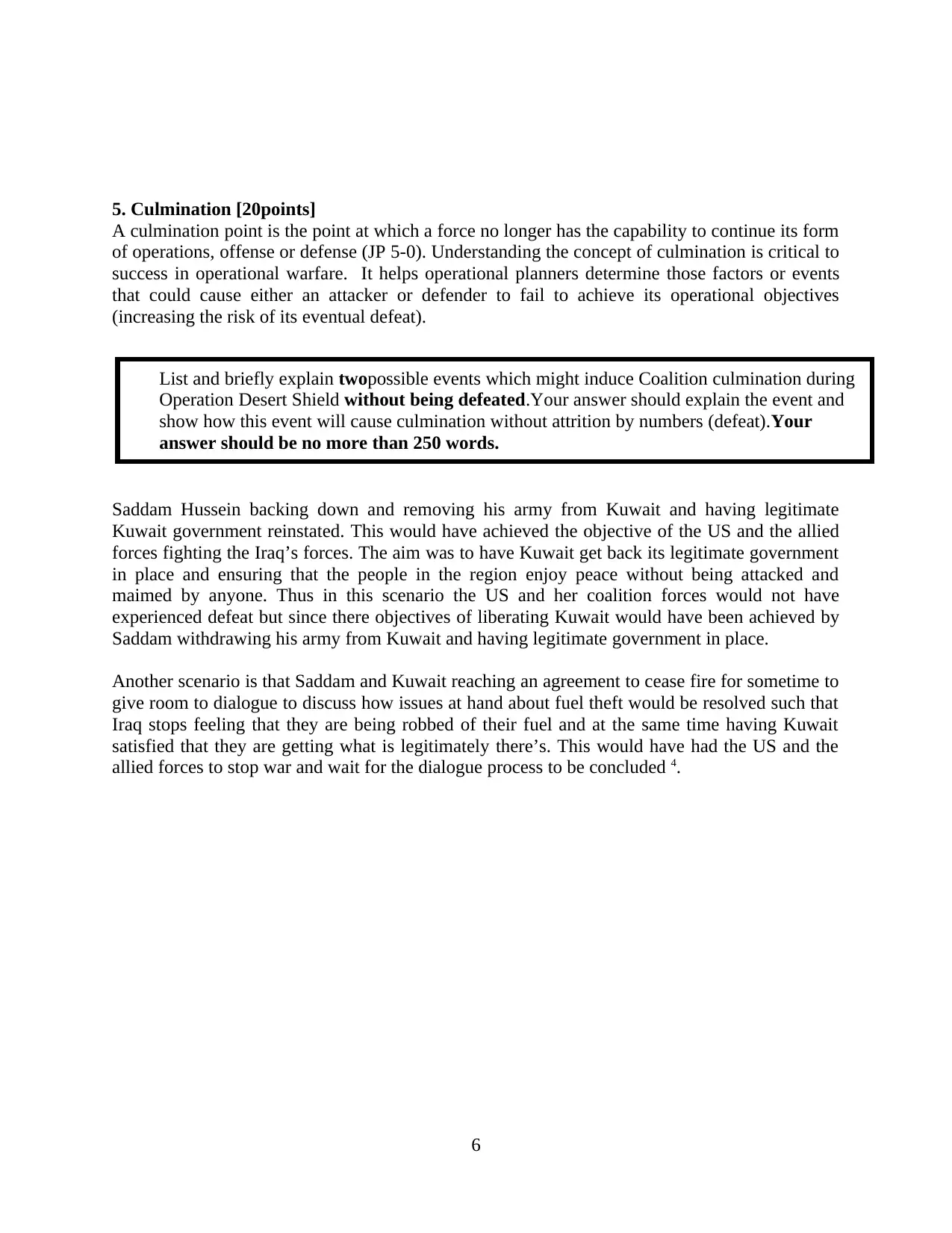
5. Culmination [20points]
A culmination point is the point at which a force no longer has the capability to continue its form
of operations, offense or defense (JP 5-0). Understanding the concept of culmination is critical to
success in operational warfare. It helps operational planners determine those factors or events
that could cause either an attacker or defender to fail to achieve its operational objectives
(increasing the risk of its eventual defeat).
Saddam Hussein backing down and removing his army from Kuwait and having legitimate
Kuwait government reinstated. This would have achieved the objective of the US and the allied
forces fighting the Iraq’s forces. The aim was to have Kuwait get back its legitimate government
in place and ensuring that the people in the region enjoy peace without being attacked and
maimed by anyone. Thus in this scenario the US and her coalition forces would not have
experienced defeat but since there objectives of liberating Kuwait would have been achieved by
Saddam withdrawing his army from Kuwait and having legitimate government in place.
Another scenario is that Saddam and Kuwait reaching an agreement to cease fire for sometime to
give room to dialogue to discuss how issues at hand about fuel theft would be resolved such that
Iraq stops feeling that they are being robbed of their fuel and at the same time having Kuwait
satisfied that they are getting what is legitimately there’s. This would have had the US and the
allied forces to stop war and wait for the dialogue process to be concluded 4.
6
List and briefly explain twopossible events which might induce Coalition culmination during
Operation Desert Shield without being defeated.Your answer should explain the event and
show how this event will cause culmination without attrition by numbers (defeat).Your
answer should be no more than 250 words.
A culmination point is the point at which a force no longer has the capability to continue its form
of operations, offense or defense (JP 5-0). Understanding the concept of culmination is critical to
success in operational warfare. It helps operational planners determine those factors or events
that could cause either an attacker or defender to fail to achieve its operational objectives
(increasing the risk of its eventual defeat).
Saddam Hussein backing down and removing his army from Kuwait and having legitimate
Kuwait government reinstated. This would have achieved the objective of the US and the allied
forces fighting the Iraq’s forces. The aim was to have Kuwait get back its legitimate government
in place and ensuring that the people in the region enjoy peace without being attacked and
maimed by anyone. Thus in this scenario the US and her coalition forces would not have
experienced defeat but since there objectives of liberating Kuwait would have been achieved by
Saddam withdrawing his army from Kuwait and having legitimate government in place.
Another scenario is that Saddam and Kuwait reaching an agreement to cease fire for sometime to
give room to dialogue to discuss how issues at hand about fuel theft would be resolved such that
Iraq stops feeling that they are being robbed of their fuel and at the same time having Kuwait
satisfied that they are getting what is legitimately there’s. This would have had the US and the
allied forces to stop war and wait for the dialogue process to be concluded 4.
6
List and briefly explain twopossible events which might induce Coalition culmination during
Operation Desert Shield without being defeated.Your answer should explain the event and
show how this event will cause culmination without attrition by numbers (defeat).Your
answer should be no more than 250 words.
You're viewing a preview
Unlock full access by subscribing today!
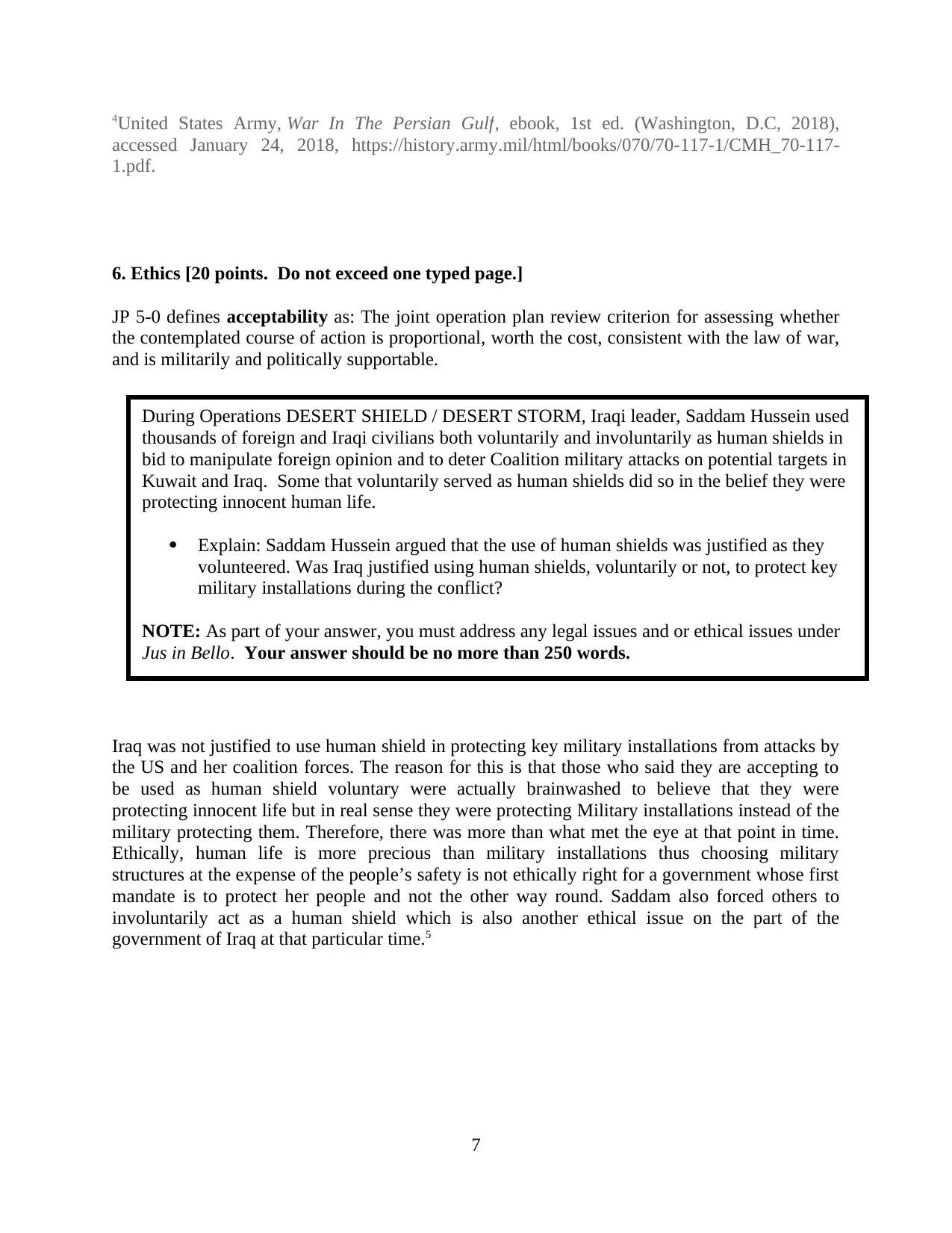
4United States Army, War In The Persian Gulf, ebook, 1st ed. (Washington, D.C, 2018),
accessed January 24, 2018, https://history.army.mil/html/books/070/70-117-1/CMH_70-117-
1.pdf.
6. Ethics [20 points. Do not exceed one typed page.]
JP 5-0 defines acceptability as: The joint operation plan review criterion for assessing whether
the contemplated course of action is proportional, worth the cost, consistent with the law of war,
and is militarily and politically supportable.
Iraq was not justified to use human shield in protecting key military installations from attacks by
the US and her coalition forces. The reason for this is that those who said they are accepting to
be used as human shield voluntary were actually brainwashed to believe that they were
protecting innocent life but in real sense they were protecting Military installations instead of the
military protecting them. Therefore, there was more than what met the eye at that point in time.
Ethically, human life is more precious than military installations thus choosing military
structures at the expense of the people’s safety is not ethically right for a government whose first
mandate is to protect her people and not the other way round. Saddam also forced others to
involuntarily act as a human shield which is also another ethical issue on the part of the
government of Iraq at that particular time.5
7
During Operations DESERT SHIELD / DESERT STORM, Iraqi leader, Saddam Hussein used
thousands of foreign and Iraqi civilians both voluntarily and involuntarily as human shields in
bid to manipulate foreign opinion and to deter Coalition military attacks on potential targets in
Kuwait and Iraq. Some that voluntarily served as human shields did so in the belief they were
protecting innocent human life.
Explain: Saddam Hussein argued that the use of human shields was justified as they
volunteered. Was Iraq justified using human shields, voluntarily or not, to protect key
military installations during the conflict?
NOTE: As part of your answer, you must address any legal issues and or ethical issues under
Jus in Bello. Your answer should be no more than 250 words.
accessed January 24, 2018, https://history.army.mil/html/books/070/70-117-1/CMH_70-117-
1.pdf.
6. Ethics [20 points. Do not exceed one typed page.]
JP 5-0 defines acceptability as: The joint operation plan review criterion for assessing whether
the contemplated course of action is proportional, worth the cost, consistent with the law of war,
and is militarily and politically supportable.
Iraq was not justified to use human shield in protecting key military installations from attacks by
the US and her coalition forces. The reason for this is that those who said they are accepting to
be used as human shield voluntary were actually brainwashed to believe that they were
protecting innocent life but in real sense they were protecting Military installations instead of the
military protecting them. Therefore, there was more than what met the eye at that point in time.
Ethically, human life is more precious than military installations thus choosing military
structures at the expense of the people’s safety is not ethically right for a government whose first
mandate is to protect her people and not the other way round. Saddam also forced others to
involuntarily act as a human shield which is also another ethical issue on the part of the
government of Iraq at that particular time.5
7
During Operations DESERT SHIELD / DESERT STORM, Iraqi leader, Saddam Hussein used
thousands of foreign and Iraqi civilians both voluntarily and involuntarily as human shields in
bid to manipulate foreign opinion and to deter Coalition military attacks on potential targets in
Kuwait and Iraq. Some that voluntarily served as human shields did so in the belief they were
protecting innocent human life.
Explain: Saddam Hussein argued that the use of human shields was justified as they
volunteered. Was Iraq justified using human shields, voluntarily or not, to protect key
military installations during the conflict?
NOTE: As part of your answer, you must address any legal issues and or ethical issues under
Jus in Bello. Your answer should be no more than 250 words.
Paraphrase This Document
Need a fresh take? Get an instant paraphrase of this document with our AI Paraphraser
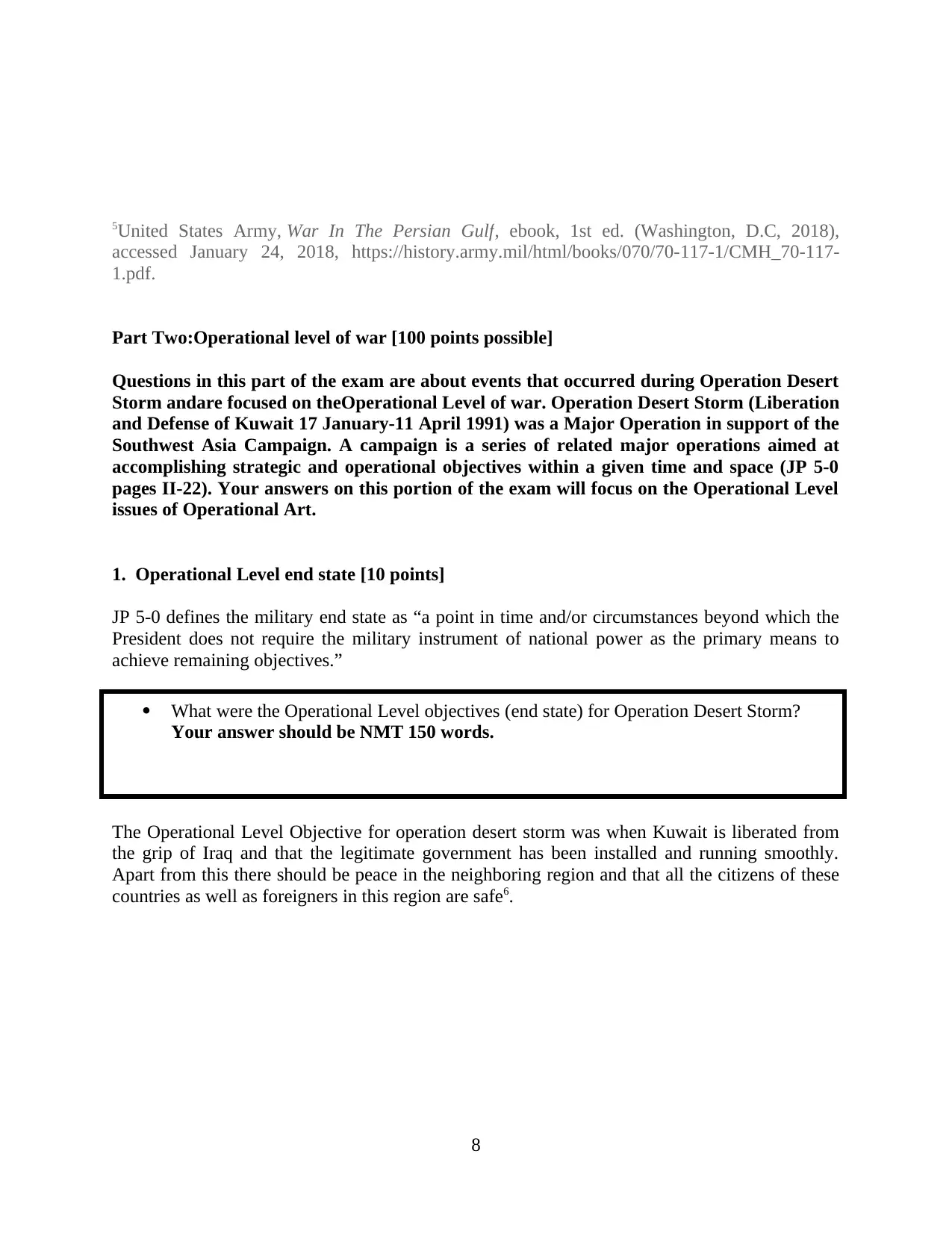
5United States Army, War In The Persian Gulf, ebook, 1st ed. (Washington, D.C, 2018),
accessed January 24, 2018, https://history.army.mil/html/books/070/70-117-1/CMH_70-117-
1.pdf.
Part Two:Operational level of war [100 points possible]
Questions in this part of the exam are about events that occurred during Operation Desert
Storm andare focused on theOperational Level of war. Operation Desert Storm (Liberation
and Defense of Kuwait 17 January-11 April 1991) was a Major Operation in support of the
Southwest Asia Campaign. A campaign is a series of related major operations aimed at
accomplishing strategic and operational objectives within a given time and space (JP 5-0
pages II-22). Your answers on this portion of the exam will focus on the Operational Level
issues of Operational Art.
1. Operational Level end state [10 points]
JP 5-0 defines the military end state as “a point in time and/or circumstances beyond which the
President does not require the military instrument of national power as the primary means to
achieve remaining objectives.”
The Operational Level Objective for operation desert storm was when Kuwait is liberated from
the grip of Iraq and that the legitimate government has been installed and running smoothly.
Apart from this there should be peace in the neighboring region and that all the citizens of these
countries as well as foreigners in this region are safe6.
8
What were the Operational Level objectives (end state) for Operation Desert Storm?
Your answer should be NMT 150 words.
accessed January 24, 2018, https://history.army.mil/html/books/070/70-117-1/CMH_70-117-
1.pdf.
Part Two:Operational level of war [100 points possible]
Questions in this part of the exam are about events that occurred during Operation Desert
Storm andare focused on theOperational Level of war. Operation Desert Storm (Liberation
and Defense of Kuwait 17 January-11 April 1991) was a Major Operation in support of the
Southwest Asia Campaign. A campaign is a series of related major operations aimed at
accomplishing strategic and operational objectives within a given time and space (JP 5-0
pages II-22). Your answers on this portion of the exam will focus on the Operational Level
issues of Operational Art.
1. Operational Level end state [10 points]
JP 5-0 defines the military end state as “a point in time and/or circumstances beyond which the
President does not require the military instrument of national power as the primary means to
achieve remaining objectives.”
The Operational Level Objective for operation desert storm was when Kuwait is liberated from
the grip of Iraq and that the legitimate government has been installed and running smoothly.
Apart from this there should be peace in the neighboring region and that all the citizens of these
countries as well as foreigners in this region are safe6.
8
What were the Operational Level objectives (end state) for Operation Desert Storm?
Your answer should be NMT 150 words.

6Joint Publication 1-02, ebook, 1st ed. (New York, 2016), accessed January 24, 2018,
https://fas.org/irp/doddir/dod/jp1_02.pdf.
2. Operational Approach[20 points]
“The operational approach reflects understanding of the operational environment and the
problem while describing the commander’s visualization of a broad approach for achieving the
desired end state” (JP 5-0, p. III-13). [Related doctrine: JP 5-0, Chapters III and IV].
General Schwarzkopf’s Operational Approach for Desert Storm involved several key
components including maneuver by VII Corps, a direct attack into Kuwait by Coalition forces
and a potential amphibious assault.
The purpose of the VII Corps was to ensure that the enemy forces that is, the Iraqi forces are
surrounded and prevented from retreating where they could go and plan themselves again.
Therefore as several other battalions were advancing towards the key strategic Iraqi forces the
VII corps work was to ensure that these key strategic units would not escape.
In a military operation envelopment is a key strategy that makes sure that the enemy is cornered
well in such as way that calling for reinforcement is difficult for them and also trying to occupy
other strategic positions further back is also challenging and almost impossible. Thus the enemy
is subdued. 7
9
Explain the purpose of VII Corps’ envelopment. Your answer should be NMT 250 words.
https://fas.org/irp/doddir/dod/jp1_02.pdf.
2. Operational Approach[20 points]
“The operational approach reflects understanding of the operational environment and the
problem while describing the commander’s visualization of a broad approach for achieving the
desired end state” (JP 5-0, p. III-13). [Related doctrine: JP 5-0, Chapters III and IV].
General Schwarzkopf’s Operational Approach for Desert Storm involved several key
components including maneuver by VII Corps, a direct attack into Kuwait by Coalition forces
and a potential amphibious assault.
The purpose of the VII Corps was to ensure that the enemy forces that is, the Iraqi forces are
surrounded and prevented from retreating where they could go and plan themselves again.
Therefore as several other battalions were advancing towards the key strategic Iraqi forces the
VII corps work was to ensure that these key strategic units would not escape.
In a military operation envelopment is a key strategy that makes sure that the enemy is cornered
well in such as way that calling for reinforcement is difficult for them and also trying to occupy
other strategic positions further back is also challenging and almost impossible. Thus the enemy
is subdued. 7
9
Explain the purpose of VII Corps’ envelopment. Your answer should be NMT 250 words.
You're viewing a preview
Unlock full access by subscribing today!
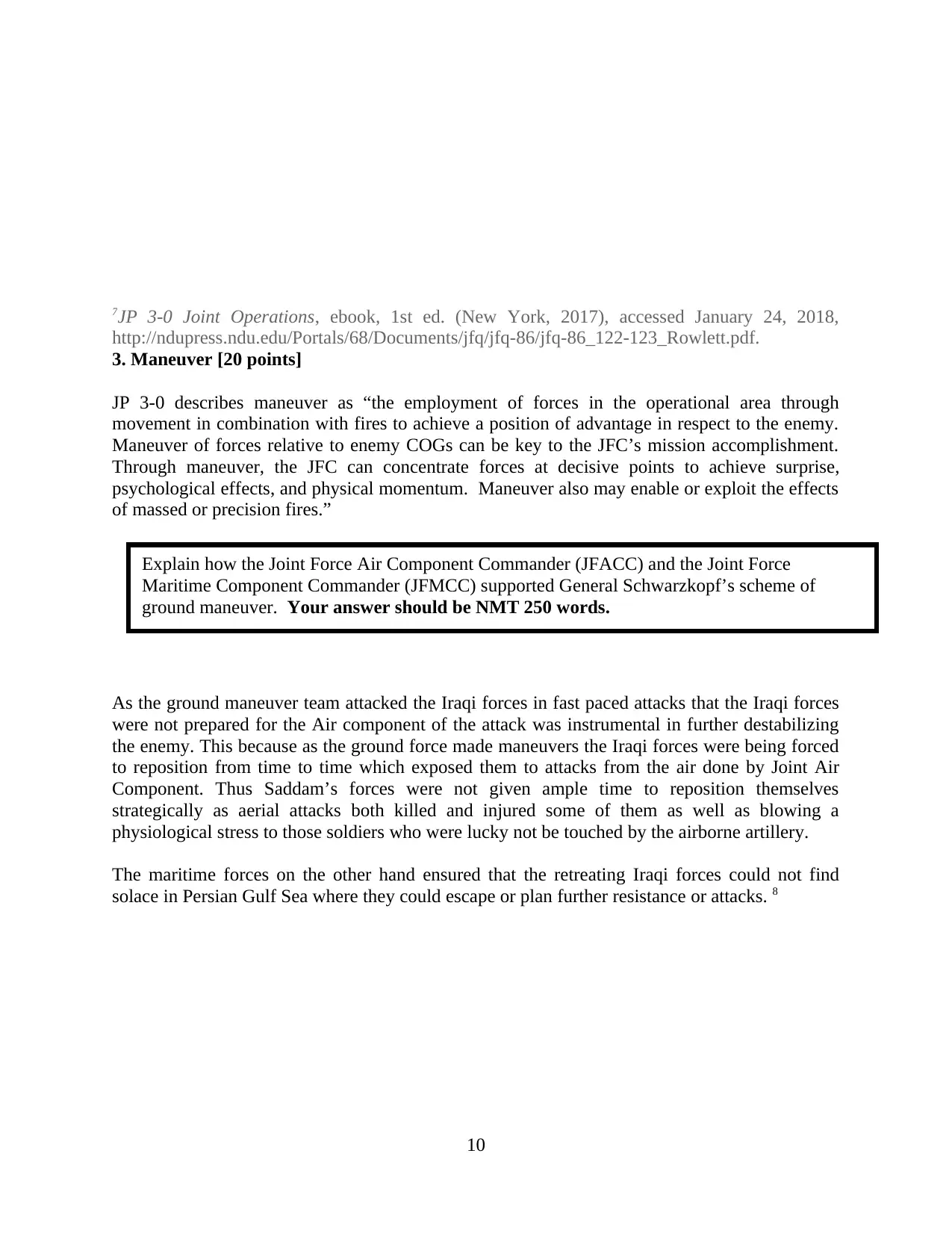
7JP 3-0 Joint Operations, ebook, 1st ed. (New York, 2017), accessed January 24, 2018,
http://ndupress.ndu.edu/Portals/68/Documents/jfq/jfq-86/jfq-86_122-123_Rowlett.pdf.
3. Maneuver [20 points]
JP 3-0 describes maneuver as “the employment of forces in the operational area through
movement in combination with fires to achieve a position of advantage in respect to the enemy.
Maneuver of forces relative to enemy COGs can be key to the JFC’s mission accomplishment.
Through maneuver, the JFC can concentrate forces at decisive points to achieve surprise,
psychological effects, and physical momentum. Maneuver also may enable or exploit the effects
of massed or precision fires.”
As the ground maneuver team attacked the Iraqi forces in fast paced attacks that the Iraqi forces
were not prepared for the Air component of the attack was instrumental in further destabilizing
the enemy. This because as the ground force made maneuvers the Iraqi forces were being forced
to reposition from time to time which exposed them to attacks from the air done by Joint Air
Component. Thus Saddam’s forces were not given ample time to reposition themselves
strategically as aerial attacks both killed and injured some of them as well as blowing a
physiological stress to those soldiers who were lucky not be touched by the airborne artillery.
The maritime forces on the other hand ensured that the retreating Iraqi forces could not find
solace in Persian Gulf Sea where they could escape or plan further resistance or attacks. 8
10
Explain how the Joint Force Air Component Commander (JFACC) and the Joint Force
Maritime Component Commander (JFMCC) supported General Schwarzkopf’s scheme of
ground maneuver. Your answer should be NMT 250 words.
http://ndupress.ndu.edu/Portals/68/Documents/jfq/jfq-86/jfq-86_122-123_Rowlett.pdf.
3. Maneuver [20 points]
JP 3-0 describes maneuver as “the employment of forces in the operational area through
movement in combination with fires to achieve a position of advantage in respect to the enemy.
Maneuver of forces relative to enemy COGs can be key to the JFC’s mission accomplishment.
Through maneuver, the JFC can concentrate forces at decisive points to achieve surprise,
psychological effects, and physical momentum. Maneuver also may enable or exploit the effects
of massed or precision fires.”
As the ground maneuver team attacked the Iraqi forces in fast paced attacks that the Iraqi forces
were not prepared for the Air component of the attack was instrumental in further destabilizing
the enemy. This because as the ground force made maneuvers the Iraqi forces were being forced
to reposition from time to time which exposed them to attacks from the air done by Joint Air
Component. Thus Saddam’s forces were not given ample time to reposition themselves
strategically as aerial attacks both killed and injured some of them as well as blowing a
physiological stress to those soldiers who were lucky not be touched by the airborne artillery.
The maritime forces on the other hand ensured that the retreating Iraqi forces could not find
solace in Persian Gulf Sea where they could escape or plan further resistance or attacks. 8
10
Explain how the Joint Force Air Component Commander (JFACC) and the Joint Force
Maritime Component Commander (JFMCC) supported General Schwarzkopf’s scheme of
ground maneuver. Your answer should be NMT 250 words.
Paraphrase This Document
Need a fresh take? Get an instant paraphrase of this document with our AI Paraphraser
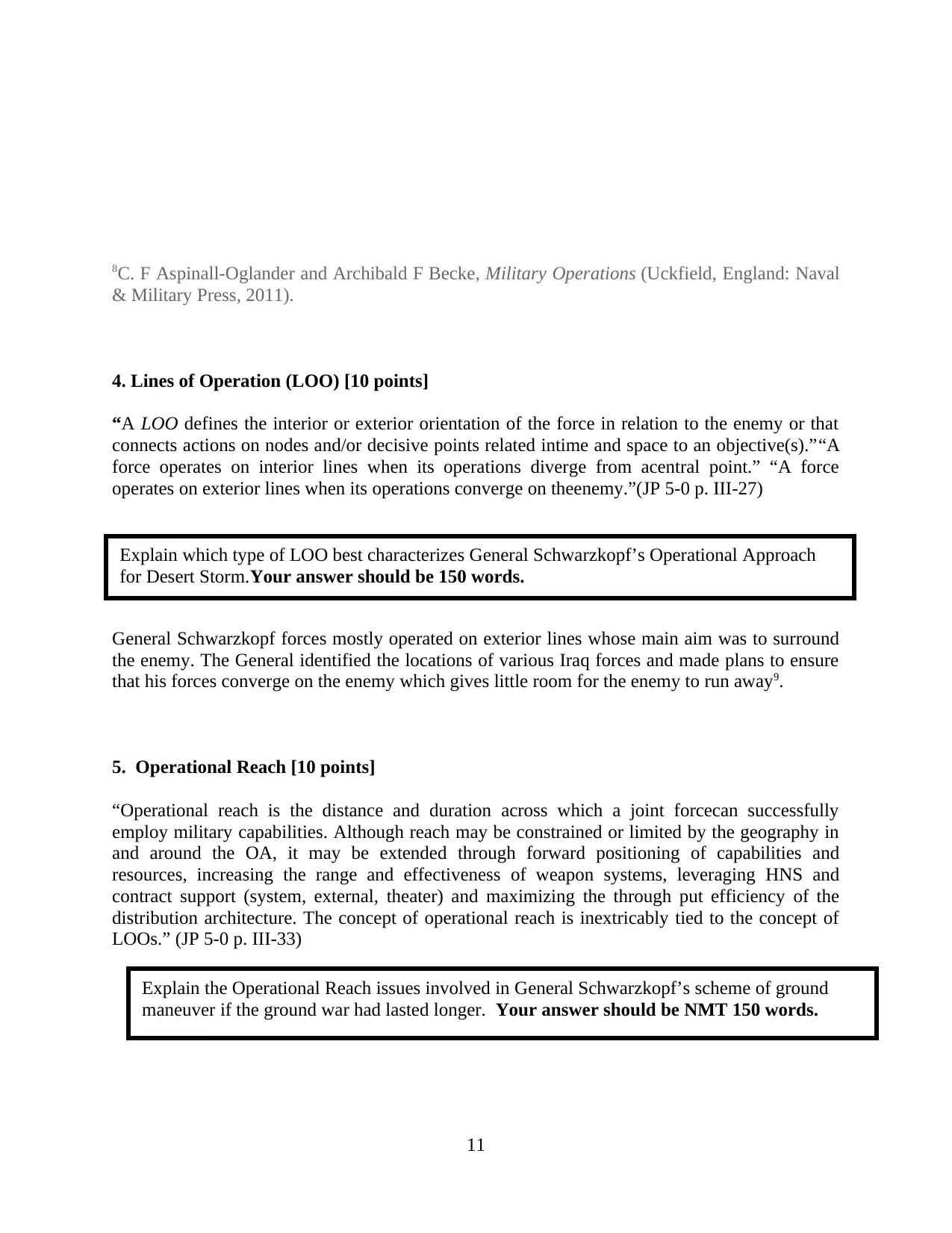
8C. F Aspinall-Oglander and Archibald F Becke, Military Operations (Uckfield, England: Naval
& Military Press, 2011).
4. Lines of Operation (LOO) [10 points]
“A LOO defines the interior or exterior orientation of the force in relation to the enemy or that
connects actions on nodes and/or decisive points related intime and space to an objective(s).”“A
force operates on interior lines when its operations diverge from acentral point.” “A force
operates on exterior lines when its operations converge on theenemy.”(JP 5-0 p. III-27)
General Schwarzkopf forces mostly operated on exterior lines whose main aim was to surround
the enemy. The General identified the locations of various Iraq forces and made plans to ensure
that his forces converge on the enemy which gives little room for the enemy to run away9.
5. Operational Reach [10 points]
“Operational reach is the distance and duration across which a joint forcecan successfully
employ military capabilities. Although reach may be constrained or limited by the geography in
and around the OA, it may be extended through forward positioning of capabilities and
resources, increasing the range and effectiveness of weapon systems, leveraging HNS and
contract support (system, external, theater) and maximizing the through put efficiency of the
distribution architecture. The concept of operational reach is inextricably tied to the concept of
LOOs.” (JP 5-0 p. III-33)
11
Explain which type of LOO best characterizes General Schwarzkopf’s Operational Approach
for Desert Storm.Your answer should be 150 words.
Explain the Operational Reach issues involved in General Schwarzkopf’s scheme of ground
maneuver if the ground war had lasted longer. Your answer should be NMT 150 words.
.
& Military Press, 2011).
4. Lines of Operation (LOO) [10 points]
“A LOO defines the interior or exterior orientation of the force in relation to the enemy or that
connects actions on nodes and/or decisive points related intime and space to an objective(s).”“A
force operates on interior lines when its operations diverge from acentral point.” “A force
operates on exterior lines when its operations converge on theenemy.”(JP 5-0 p. III-27)
General Schwarzkopf forces mostly operated on exterior lines whose main aim was to surround
the enemy. The General identified the locations of various Iraq forces and made plans to ensure
that his forces converge on the enemy which gives little room for the enemy to run away9.
5. Operational Reach [10 points]
“Operational reach is the distance and duration across which a joint forcecan successfully
employ military capabilities. Although reach may be constrained or limited by the geography in
and around the OA, it may be extended through forward positioning of capabilities and
resources, increasing the range and effectiveness of weapon systems, leveraging HNS and
contract support (system, external, theater) and maximizing the through put efficiency of the
distribution architecture. The concept of operational reach is inextricably tied to the concept of
LOOs.” (JP 5-0 p. III-33)
11
Explain which type of LOO best characterizes General Schwarzkopf’s Operational Approach
for Desert Storm.Your answer should be 150 words.
Explain the Operational Reach issues involved in General Schwarzkopf’s scheme of ground
maneuver if the ground war had lasted longer. Your answer should be NMT 150 words.
.
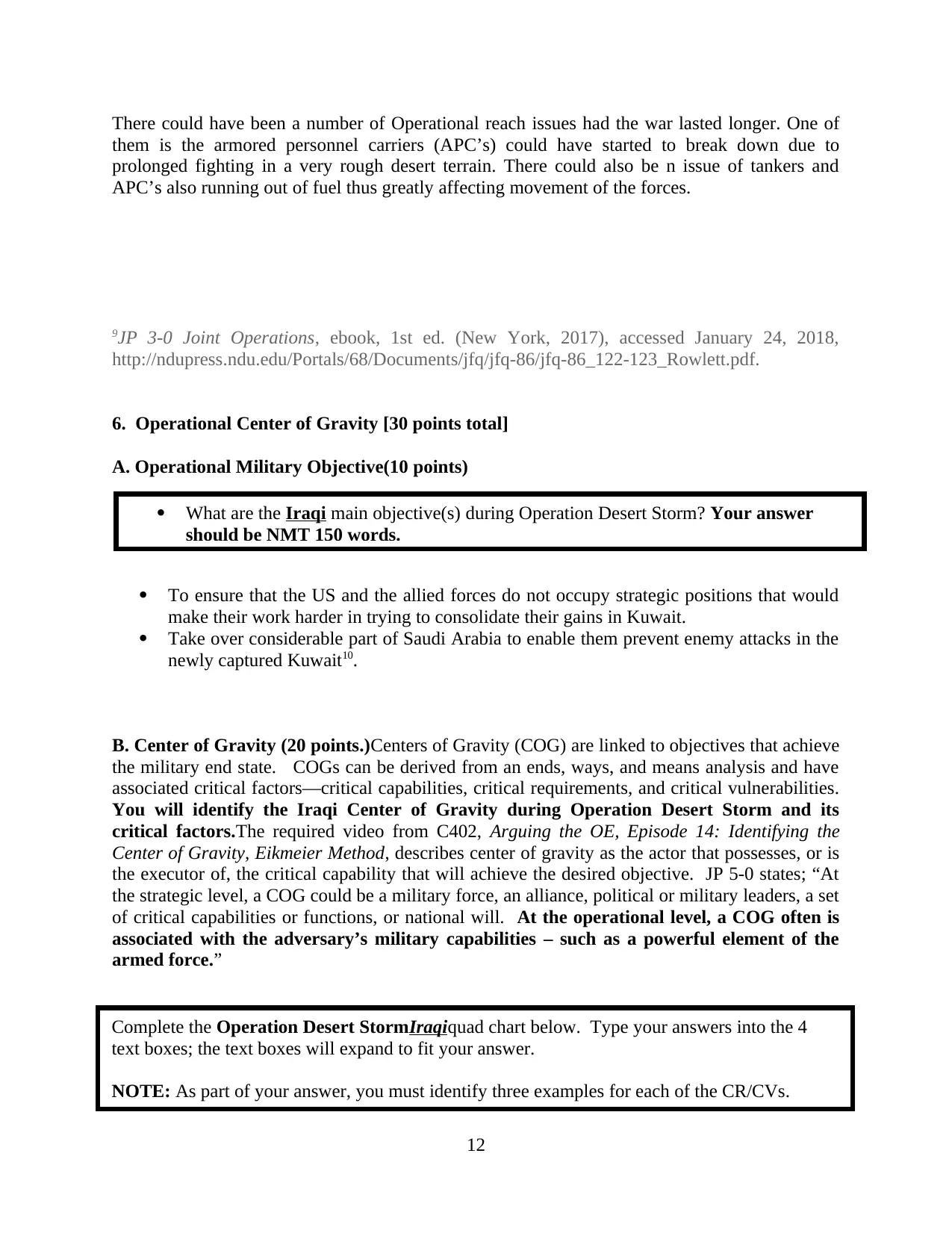
There could have been a number of Operational reach issues had the war lasted longer. One of
them is the armored personnel carriers (APC’s) could have started to break down due to
prolonged fighting in a very rough desert terrain. There could also be n issue of tankers and
APC’s also running out of fuel thus greatly affecting movement of the forces.
9JP 3-0 Joint Operations, ebook, 1st ed. (New York, 2017), accessed January 24, 2018,
http://ndupress.ndu.edu/Portals/68/Documents/jfq/jfq-86/jfq-86_122-123_Rowlett.pdf.
6. Operational Center of Gravity [30 points total]
A. Operational Military Objective(10 points)
To ensure that the US and the allied forces do not occupy strategic positions that would
make their work harder in trying to consolidate their gains in Kuwait.
Take over considerable part of Saudi Arabia to enable them prevent enemy attacks in the
newly captured Kuwait10.
B. Center of Gravity (20 points.)Centers of Gravity (COG) are linked to objectives that achieve
the military end state. COGs can be derived from an ends, ways, and means analysis and have
associated critical factors—critical capabilities, critical requirements, and critical vulnerabilities.
You will identify the Iraqi Center of Gravity during Operation Desert Storm and its
critical factors.The required video from C402, Arguing the OE, Episode 14: Identifying the
Center of Gravity, Eikmeier Method, describes center of gravity as the actor that possesses, or is
the executor of, the critical capability that will achieve the desired objective. JP 5-0 states; “At
the strategic level, a COG could be a military force, an alliance, political or military leaders, a set
of critical capabilities or functions, or national will. At the operational level, a COG often is
associated with the adversary’s military capabilities – such as a powerful element of the
armed force.”
12
What are the Iraqi main objective(s) during Operation Desert Storm? Your answer
should be NMT 150 words.
Complete the Operation Desert StormIraqiquad chart below. Type your answers into the 4
text boxes; the text boxes will expand to fit your answer.
NOTE: As part of your answer, you must identify three examples for each of the CR/CVs.
them is the armored personnel carriers (APC’s) could have started to break down due to
prolonged fighting in a very rough desert terrain. There could also be n issue of tankers and
APC’s also running out of fuel thus greatly affecting movement of the forces.
9JP 3-0 Joint Operations, ebook, 1st ed. (New York, 2017), accessed January 24, 2018,
http://ndupress.ndu.edu/Portals/68/Documents/jfq/jfq-86/jfq-86_122-123_Rowlett.pdf.
6. Operational Center of Gravity [30 points total]
A. Operational Military Objective(10 points)
To ensure that the US and the allied forces do not occupy strategic positions that would
make their work harder in trying to consolidate their gains in Kuwait.
Take over considerable part of Saudi Arabia to enable them prevent enemy attacks in the
newly captured Kuwait10.
B. Center of Gravity (20 points.)Centers of Gravity (COG) are linked to objectives that achieve
the military end state. COGs can be derived from an ends, ways, and means analysis and have
associated critical factors—critical capabilities, critical requirements, and critical vulnerabilities.
You will identify the Iraqi Center of Gravity during Operation Desert Storm and its
critical factors.The required video from C402, Arguing the OE, Episode 14: Identifying the
Center of Gravity, Eikmeier Method, describes center of gravity as the actor that possesses, or is
the executor of, the critical capability that will achieve the desired objective. JP 5-0 states; “At
the strategic level, a COG could be a military force, an alliance, political or military leaders, a set
of critical capabilities or functions, or national will. At the operational level, a COG often is
associated with the adversary’s military capabilities – such as a powerful element of the
armed force.”
12
What are the Iraqi main objective(s) during Operation Desert Storm? Your answer
should be NMT 150 words.
Complete the Operation Desert StormIraqiquad chart below. Type your answers into the 4
text boxes; the text boxes will expand to fit your answer.
NOTE: As part of your answer, you must identify three examples for each of the CR/CVs.
You're viewing a preview
Unlock full access by subscribing today!

10Charles Hordern and H. Fitz M Stacke, Military Operations (Uckfield, England: Naval &
Military Press, 2011).
13
Type answers here:
-Availability of strong military
equipments such as Tankers,
Bombers and sophisticated gun.
Type answer here:
-Joint enemy forces –means more
firepower.
Type answers here:
- Aerial support – More
sophisticated bombers,
skilled fighter jets pilots,
Radar capabilities
Type answers here:
-lack of adequate experience in
fast paced offensive military attack
- Lack of support from neighboring
countries11
Military Press, 2011).
13
Type answers here:
-Availability of strong military
equipments such as Tankers,
Bombers and sophisticated gun.
Type answer here:
-Joint enemy forces –means more
firepower.
Type answers here:
- Aerial support – More
sophisticated bombers,
skilled fighter jets pilots,
Radar capabilities
Type answers here:
-lack of adequate experience in
fast paced offensive military attack
- Lack of support from neighboring
countries11
Paraphrase This Document
Need a fresh take? Get an instant paraphrase of this document with our AI Paraphraser

11Charles Hordern and H. Fitz M Stacke, Military Operations (Uckfield, England: Naval &
Military Press, 2011).
***** FOR INSTRUCTOR USE ONLY ON THIS PAGE *******
C402 PART ONE SCORING
Requirement # Requirement Value Requirement
1 20 Describing the Operational Environment
2 10 U.S. Theater Strategic Level objectives
3 20 Identifying Operational Risk
4 10 Decisive Points
5 20 Culmination
6 20 Ethics
C402 PART TWO SCORING
Requirement # Requirement Value Requirement
1 10 Operational Level end state
2 20 Operational Approach
3 20 Maneuver
4 10 Lines of Operation
5 10 Operational Reach
6 30 Center of Gravity
TOTAL SCORE =
INSTRUCTOR COMMENTS:
Grader: ________________________
14
Military Press, 2011).
***** FOR INSTRUCTOR USE ONLY ON THIS PAGE *******
C402 PART ONE SCORING
Requirement # Requirement Value Requirement
1 20 Describing the Operational Environment
2 10 U.S. Theater Strategic Level objectives
3 20 Identifying Operational Risk
4 10 Decisive Points
5 20 Culmination
6 20 Ethics
C402 PART TWO SCORING
Requirement # Requirement Value Requirement
1 10 Operational Level end state
2 20 Operational Approach
3 20 Maneuver
4 10 Lines of Operation
5 10 Operational Reach
6 30 Center of Gravity
TOTAL SCORE =
INSTRUCTOR COMMENTS:
Grader: ________________________
14
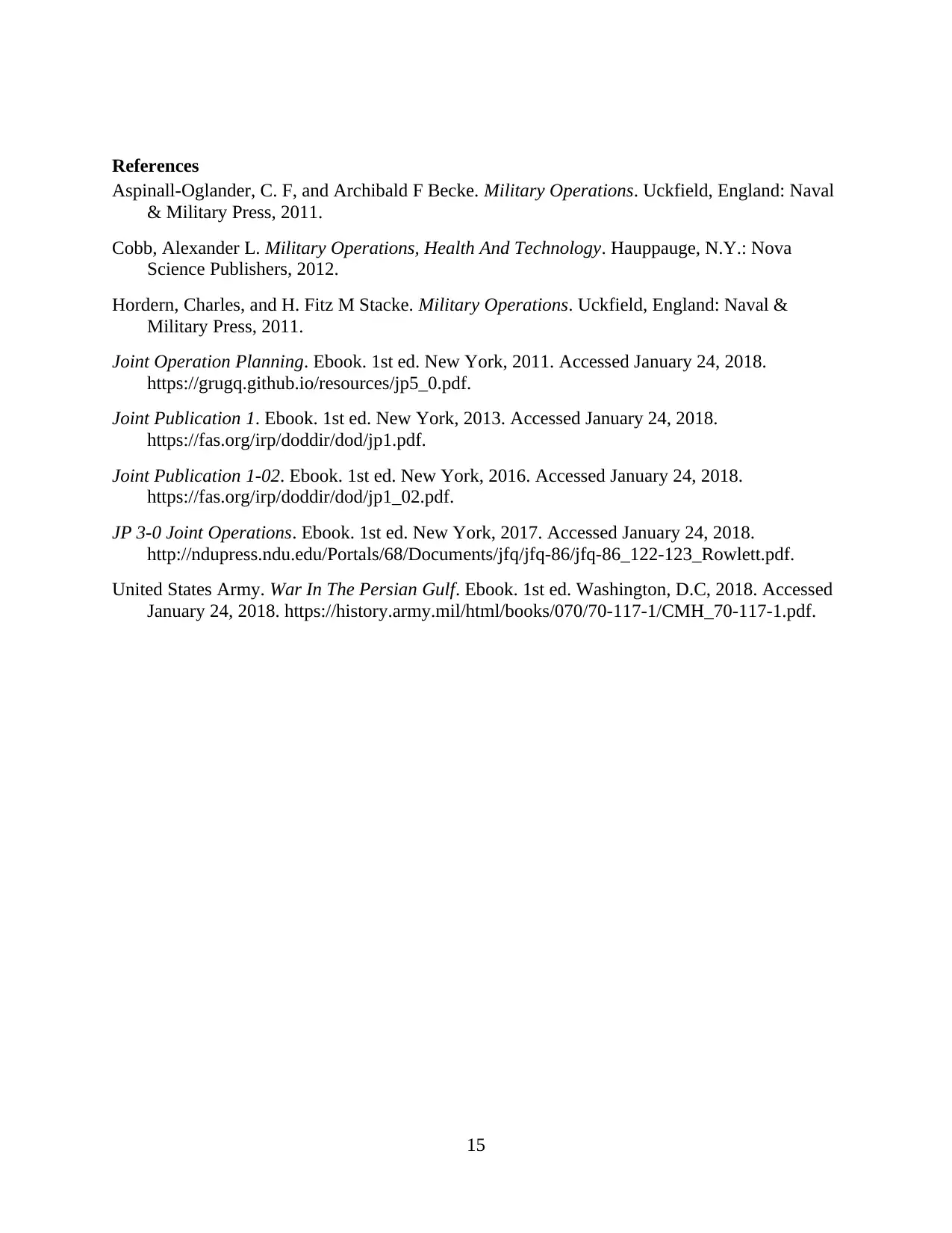
References
Aspinall-Oglander, C. F, and Archibald F Becke. Military Operations. Uckfield, England: Naval
& Military Press, 2011.
Cobb, Alexander L. Military Operations, Health And Technology. Hauppauge, N.Y.: Nova
Science Publishers, 2012.
Hordern, Charles, and H. Fitz M Stacke. Military Operations. Uckfield, England: Naval &
Military Press, 2011.
Joint Operation Planning. Ebook. 1st ed. New York, 2011. Accessed January 24, 2018.
https://grugq.github.io/resources/jp5_0.pdf.
Joint Publication 1. Ebook. 1st ed. New York, 2013. Accessed January 24, 2018.
https://fas.org/irp/doddir/dod/jp1.pdf.
Joint Publication 1-02. Ebook. 1st ed. New York, 2016. Accessed January 24, 2018.
https://fas.org/irp/doddir/dod/jp1_02.pdf.
JP 3-0 Joint Operations. Ebook. 1st ed. New York, 2017. Accessed January 24, 2018.
http://ndupress.ndu.edu/Portals/68/Documents/jfq/jfq-86/jfq-86_122-123_Rowlett.pdf.
United States Army. War In The Persian Gulf. Ebook. 1st ed. Washington, D.C, 2018. Accessed
January 24, 2018. https://history.army.mil/html/books/070/70-117-1/CMH_70-117-1.pdf.
15
Aspinall-Oglander, C. F, and Archibald F Becke. Military Operations. Uckfield, England: Naval
& Military Press, 2011.
Cobb, Alexander L. Military Operations, Health And Technology. Hauppauge, N.Y.: Nova
Science Publishers, 2012.
Hordern, Charles, and H. Fitz M Stacke. Military Operations. Uckfield, England: Naval &
Military Press, 2011.
Joint Operation Planning. Ebook. 1st ed. New York, 2011. Accessed January 24, 2018.
https://grugq.github.io/resources/jp5_0.pdf.
Joint Publication 1. Ebook. 1st ed. New York, 2013. Accessed January 24, 2018.
https://fas.org/irp/doddir/dod/jp1.pdf.
Joint Publication 1-02. Ebook. 1st ed. New York, 2016. Accessed January 24, 2018.
https://fas.org/irp/doddir/dod/jp1_02.pdf.
JP 3-0 Joint Operations. Ebook. 1st ed. New York, 2017. Accessed January 24, 2018.
http://ndupress.ndu.edu/Portals/68/Documents/jfq/jfq-86/jfq-86_122-123_Rowlett.pdf.
United States Army. War In The Persian Gulf. Ebook. 1st ed. Washington, D.C, 2018. Accessed
January 24, 2018. https://history.army.mil/html/books/070/70-117-1/CMH_70-117-1.pdf.
15
You're viewing a preview
Unlock full access by subscribing today!
1 out of 15
Your All-in-One AI-Powered Toolkit for Academic Success.
+13062052269
info@desklib.com
Available 24*7 on WhatsApp / Email
![[object Object]](/_next/static/media/star-bottom.7253800d.svg)
Unlock your academic potential
© 2024 | Zucol Services PVT LTD | All rights reserved.